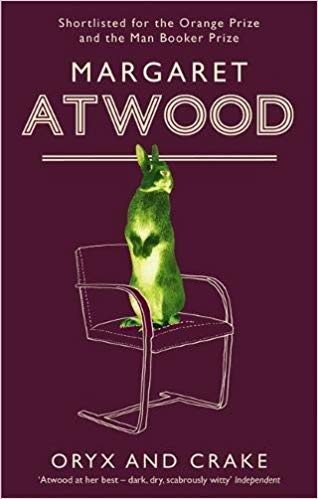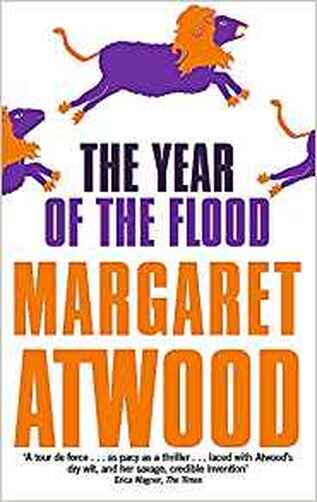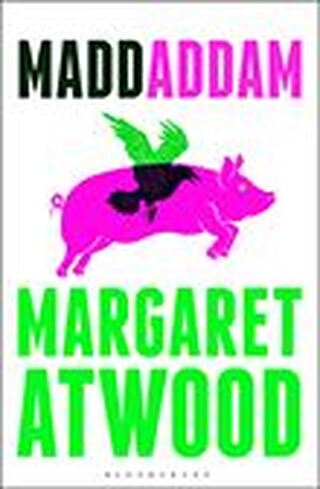Oryx and Crake, The Year of the Flood, MaddAddam
Anne Chapman reviews this trilogy of novels by Margaret Atwood which are set in the future after climate change has really hit us. It is not a far distant future: at one point we learn that it is the twenty-first century



Published by Bloomsbury, 2003, 2009 and 2013
Atwood has thought through what life in a world with a changed climate change might be like, and we can perhaps learn from this. She has described these novels as ‘speculative fiction’ (Atwood 2004, 330): the technologies described either already exist, are under construction or possible in theory (Atwood 2013, 393). About the The Year of the Flood, she has said: ‘the general tendencies and many of the details in it are alarmingly close to fact’ (Atwood 2009, 517).
The novels are set in the USA, with the main location being somewhere on the East Coast – or at least what is now the East Coast: the main East Coast cities have been flooded and abandoned. New York is officially a no-go zone, but a few people ‘take their chances in the disintegrating, waterlogged, derelict buildings’ as they can live there rent free (Atwood 2013, 186). There is a ‘New New York’ on what is now the Jersey shore. Harvard is no more as it too is flooded (Atwood 2003, 203). Coastal aquifers have turned salty (Atwood 2003, 27). The city in which the novels are set has a shore line. There are tower blocks standing in the water which now house nesting birds and under the water are ‘ersatz reefs of rusted car parts and jumbled bricks and assorted rubble’ (Atwood 2003, 3). The sea level rose quickly, washing away beaches, helped perhaps by a huge tidal wave from a Canary Islands volcano (Atwood 2003, 71).
Where there used to be winter, spring, summer and autumn, now there is rainy, stormy, hot and dry, cooler and dry, rainy and warm (Atwood 2009, 117). Graduation ceremonies had previously been held in June, when the weather was generally sunny and moderate, but the graduation ceremony in Oryx and Crake had to be held in early February as June was in the wet season with thunderstorms every day. Even then it was humid and ‘they’d ducked a twister by only one day’ (Atwood 2003, 203). The elite escape the heat by going on holiday in a gated vacation community on the western shore of Hudson’s Bay (Atwood 2003, 209). In Florida the rains have stopped coming, drying up fruit orchards, shrinking Lake Okeechobee to a ‘reeking mud puddle’ and the Everglades have burned (Atwood 2003, 72). Texas has ‘dried up and blown away’ (Atwood 2003, 287) – they built a wall to try to keep out the resulting tide of ‘Tex-Mex’ refugees (Atwood 2009, 102). We also learn that the northern permafrost has melted, releasing its stored methane, that prolonged drought has hit the midcontinental plains and the Asian Steppes have turned into sand dunes (Atwood 2003, 27).
These changes in climate mean that meat is hard to come by. Atwood’s novels are usually full of the details of everyday life. In some books, such as Cat’s Eye (1988) we get descriptions of what a character wears as they pass through the different stages of their life. In these novels it is food that features prominently. The elite occasionally have real food. The fact that a cake at a wedding has real fresh eggs in it is something to be proud of. Lamb chops and genuine Brie are prizes in game shows (Atwood 2003, 97). There is a gourmet restaurant called Rarity where it is believed that endangered species are served in the private dining rooms (Atwood 2009, 37). Everyone else seems to eat lots of soya dressed up to look like other things: CrustaeSoy (fake shrimps), Choco-Nutrino (containing burnt soya to substitute for chocolate after the world chocolate crop had failed - Atwood 2013, 141), SoYummie soy ice cream, SoyOBoy burgers, soydines, soybits, soybread. Or there are SecretBurgers, a fast food franchise, where the secret is the type of animal protein they contain – perhaps including cat, or mouse, or even the odd human (Atwood 2009, 40). There is also meat that has been grown as a lab-culture from cells and genetically engineered chickens which lack brains and just grow breasts, or drums sticks, called ChickieNobs (Atwood 2003, 238).
As well as being about life after climate change, the trilogy, in particular Oryx and Crake, can be regarded as being about genetic engineering. At school the main character, Jimmy and his best friend Glenn (aka Crake) study ‘Nanotech Biochem’ and do a splicing project which involves producing a purple nematode ‘using the colour coder from a primitive seaweed’ (Atwood 2003, 87). Jimmy’s father had worked for OrganInc Farms, where he was involved in breeding huge pigs, known as pigoons, which had human genes and were used for growing organs for transplant into humans (Atwood 2003, 25). When he is at college Jimmy visits Crake who is at the prestigious Watson-Crick Institute. There they are breeding Wolvogs, which look like dogs, who wag their tails and look at you with puppy dog eyes, but in fact are totally vicious. They were for use in prison moats. Jimmy asks ‘What if they get out?’ Crake admits that this would be a problem but implies that it is unlikely (Atwood 2003, 241). However, years later, after Crake manages to wipe out most of humanity through a microbe embedded in pills called BlyssPluss (supposed to protect against sexually transmitted diseases, increase libido and prolong youth – Atwood 2003, 346) the wolvogs and the pigoons both get out and become Jimmy’s adversaries. Unbeknownst to him he was inoculated against the disease unleased by Crake and is living up a tree, thinking that he is the last person left on earth, looking after Crake’s other creation: a new type of human being engineered to be peaceful herbivores, that Jimmy calls Crakers.
Other genetically engineered organisms include huge green rabbits, rakunks (a cross between a racoon and a skunk which make good pets), liobams (lion/sheep), Mo’Hairs (who have human hair that can be transplanted onto people), lumi-roses and very large butterflies. A coffee company, Happicuppa, genetically engineers a coffee bush where all the beans ripen at the same time, so can be grown in huge plantations and harvested by machine. It puts all the small growers out of business and sparks a global protest movement. Crake’s problem with it is that they are destroying the cloud forest to plant it (Atwood 2003, 210).
Genetically engineered organisms are used as weapons of resistance by the MaddAddam group. They create parasites that carry a modified form of chickenpox specific to the ChickieNob, a house mouse addicted to the insulation on electric wiring, a pesticide-resistant bean weevil that decimates Happicuppa coffee crops and a microbe that eats the tar in asphalt (Atwood 2003, 253).
This world is run by corporations. Their staff live in secure compounds: clean, orderly places with solar-skins on the houses to generate electricity, containing shops, schools and leisure facilities where what and who goes in and out is carefully controlled. They worry about infection by ‘hostile bioforms’ as well as rival corporations stealing their secrets or staff. Inside the compounds you can cycle or use electric golf carts, and you can travel between them in bullet trains. Outside are ‘modules’ (gated communities which we don’t hear much about) and then the pleeblands where polluting fuels are still used. For Jimmy, a compound kid, the pleeblands are chaotic, dirty and dangerous, but nonetheless have an exciting allure (Atwood 2003, 231). There seems to be no functioning democratic government. As teenagers Crake and Jimmy spent some time watching current-affairs shows about world political leaders, but these were ‘toppled and replaced with such rapidity that it hardly mattered’ whether they actually existed or had said what they were shown as saying (Atwood 2003, 1994). Law enforcement is done by the CorpsSeCorps. This ‘started out as a private security firm for the Corporations but then they’d taken over when local police forces collapsed because of lack of funding and people liked that at first because the Corporations paid, but now CorpSeCorps were sending their tentacles everywhere.’ (Attwood 2009, 30).
All the corporations mentioned by Atwood are involved in health and personal wellbeing. There’s HelthWyzer, AnooYoo, RejoovenEsense and CryoJeenyus. These are all about treatment/improvement of the individual, including engineering their genes. The length that these corporations will go to make money is exemplified by HelthWyzer: they put a disease-causing organism in their vitamin pills and then charged the people for treatment of the resulting illness (Atwood 2003, 247). The mother of Toby, one of the main characters in The Year of the Flood and MaddAddam died in this way, after the family had spent all they had on medical bills (Atwood, 2009, 31-33). Toby’s father then committed suicide and, after burying him under the patio of the next door house, Toby disappears into the pleeblands to avoid the debts: for the CopsSeCorps never wrote off debts (Atwood 2009, 144).
The commercialisation of society is also seen in the decline of culture and the arts: Jimmy goes to the Martha Graham Academy, a former arts and humanities college. A lot of what went on at Martha Graham was ‘like studying Latin or bookbinding: pleasant to contemplate in its way but no longer central to anything’ (Atwood 2003, 219). Jimmy studies ‘Problematics’, nicknamed ‘Spin and Grin’, which basically seems to be about writing marketing copy. ‘Like everything at Martha Graham it had utilitarian aims.’ (Atwood 2003, 220). Martha Graham is falling apart, whereas the Watson-Crick Institute is clearly much more prosperous. But science too is confined to utilitarian aims. At Watson-Crick students ‘got half the royalties from anything they invented there’, which Crake thinks is a ‘fierce incentive’ (Atwood 2003, 238). The focus on making money, rather than on the pursuit of science, results in some scientists leaving the corporations and joining the God’s Gardeners, or MaddAddam.
The God’s Gardeners are a small religious sect who try to reconcile a Christian, sacramental view of life with the findings of science. They play a prominent part in The Year of the Flood. Their saints are scientists and environmentalists, including Linnaeus, Stephen Jay Gould, Dian Fossey, Rachel Carson, E.F. Schmacher and Jacques Cousteau. They live in run-down buildings in the pleeblands where they tend vegetables and bees in a roof-top garden and grow mushrooms in the cellars. They scavenge old soap from hotels and make vinegar from wine found in half-drunk bottles in skips. They are pacifist vegetarians, believing that animals are not senseless matter but have living souls, though teach their children survival skills such as how to trap and skin rabbits. They eat turnip pie, pickled mushroom medley and lentil soup as well as foraged wild strawberries, fiddleheads and milkweed pods. They could be viewed as a religious version of the transition movement, but rather than worrying about peak oil they are preparing for a ‘waterless flood’. Their reasoning is that after the Flood in the Old Testament God promised never to flood the earth again, but Man has cursed it and the result will be a Waterless Flood – a plague of some sort. The Gardeners plan to survive this by constructing Ararats – hidden places with stores of canned and dried food in which they can live during the plague. The Gardeners remember the names of extinct species: lions, tigers, and many other species are now extinct. They grow in influence, developing a network of communities as well as ‘Exfernal’ cells of sympathizers. They harbour defectors from the corporations and are aware that their stance against commercial activities might be seen as opposition, which is not tolerated by the Corporations (Atwood 2009, 226 and 289). There comes a point when the rate of species extinction is such that some in the Gardeners think that more active opposition is needed. A group leaves the Gardeners and sets up MaddAddam. Later the roof-top garden is destroyed and the Gardeners are forced to go underground. However, with the help of their Ararats, some do survive the plague engineered by Crake – who was perhaps influenced by the Gardeners belief in a Waterless Flood.
Quizzed by Toby about the theological disputes that the Gardeners have, Adam, who founded them, says ‘most people don’t care about other Species, not when times get hard .... but what if it’s God who is doing the caring? .... The strictly materialist view ... is far too harsh and lonely for most, and leads to nihilism. That being the case we need to push popular sentiment in a biosphere-friendly direction by pointing out the hazards of annoying God by a violation of His trust in our stewardship.’ Toby says: ‘What you mean is with God in the story there’s a penalty’. (Atwood 2009, 287-288). Perhaps a religious basis is also needed to hold a community such as the Gardeners together, a community which holds very different values to those of the society around it. In his Radio 4 series, Living with the Gods, Neil MacGregor argued that the decline in religion in Western society has not led to a break down in morality, as some had feared, but it has resulted in a loss of community. As things get more difficult we will need stronger communities and perhaps religion will play a part in creating these.
There are alternative, less benign, religions in Atwood’s trilogy. We hear a bit about the ‘Wolf Isaiahists’ and ‘Known Fruits’. The latter ‘claimed it was a mark of God’s favour to be rich because By their fruits ye shall know them, and fruits meant bank accounts’ (Atwood 2009, 344). In MaddAddam we learn about the Church of PetrOleum, which is affiliated to the more mainstream Petrobaptists and did really well when ‘accessible oil became scarce and the price shot up and desperation among the pleebs set it’ (Atwood, 2013, 111). This takes the biblical ‘Thou art Peter and upon this rock I will build my church’ (Matthew, Chapter 16, verse 18) as referring to petroleum when it says Peter. Fossil fuels are therefore gifts from God to be used to the full (Atwood 2013, 111-113). Genesis is interpreted as saying that animals have been made for the sole pleasure and use of Man, and therefore can be exterminated (Atwood 2013, 194). These Christian sects seem eerily like current day US Republicans: they regard anyone who objects to pollution as ‘hell-bent on sabotaging the American Way and God’s Holy Oil’ (Atwood 2013, 182).
As a novelist Atwood excels in portraying what things feel like. In Oryx and Crake Jimmy’s mother is clearly grieving for all that has been lost – the beach house that her family had owned when she was a child, her grandfather’s grapefruit orchard (p.71-2). Jimmy entertains his friends by parodying their parents’ complaining about how things used to be so much better. Depression is common amongst the Gardeners: they call it a fallow state, and consider the person to be resting, retreating into themselves to gain spiritual insight (Atwood 2009, 97). Looking back after the Waterless Flood has hit, Toby (who is the same generation as Jimmy’s mother) thinks that she was an optimistic child. She knew that there were things wrong in the world, but they were elsewhere. By the time she got to college the wrongness had come closer. It was an oppressive sensation that nobody talked about. If people discussed it
"you tuned them out, because what they were saying was both so obvious and so unthinkable. ‘We’re using up the Earth. It’s almost gone. You can’t live with such fears and keep on whistling. The waiting builds up in you like a tide. You start wanting it to be done with. You find yourself saying to the sky, Just do it. Do your worst. Get it over with. She could feel the coming tremor of it running through her spine, asleep or awake. It never went away, even among the Gardeners. Especially – as time wore on – among the Gardeners.” (Atwood 2009, 285).
Is this what life is going to be like for those who are children now?
Attwood has said that the what if of Oryx and Crake is ‘What if we continue down the road we are already on? How slippery is the slope? What are our saving graces? Who’s got the will to stop us? (Atwood 2004, 330). In that it is a continuation of current trends the world of this trilogy is all too believable: it is a possible future, even if not all the genetically engineered organisms are possibilities. However, trends rarely continue in the same direction for long, so there is hope that it won’t come to pass.
Generally Atwood drip-feeds information about the world she is writing about in a plausible way but there are bits of clunkiness, particularly in the reminiscences of past times between Toby and Zeb in MaddAddam. Plus there are some inconsistencies between the books: the timing of the Happicuppa riots in Oryx and Crake does not match that in The Year of the Flood; in The Year of the Flood the Gardeners keep bees, but in MaddAddam Zeb and Toby discuss how the big bee die-off took place shortly before the Gardeners were keeping them, making fruit very expensive. Atwood also has the problem of technology changing while she writes the trilogy: there are laptops and computers in Oryx and Crake and The Year of the Flood, but no tablets: these are only mentioned in Maddadam, as something that Toby used in her childhood to do her homework.
Most people do not think about what climate change is going to do to the world. That Atwood has done so is a great service. Although what she portrays is frightening, it does suggest that life will go on, and that there will be things to strive for even after the world has warmed and the seas have risen. This is Jimmy, watching the sun rise at the end of Oryx and Crake:
"On the eastern horizon there’s a greyish haze, lit now with a rosy, deadly glow. Strange how that colour still seems tender. He gazes at it with rapture; there is no other word for it. Rapture. The heart seized, carried away, as if by some large bird of prey. After everything that has happened how can the world still be so beautiful? Because it is."



